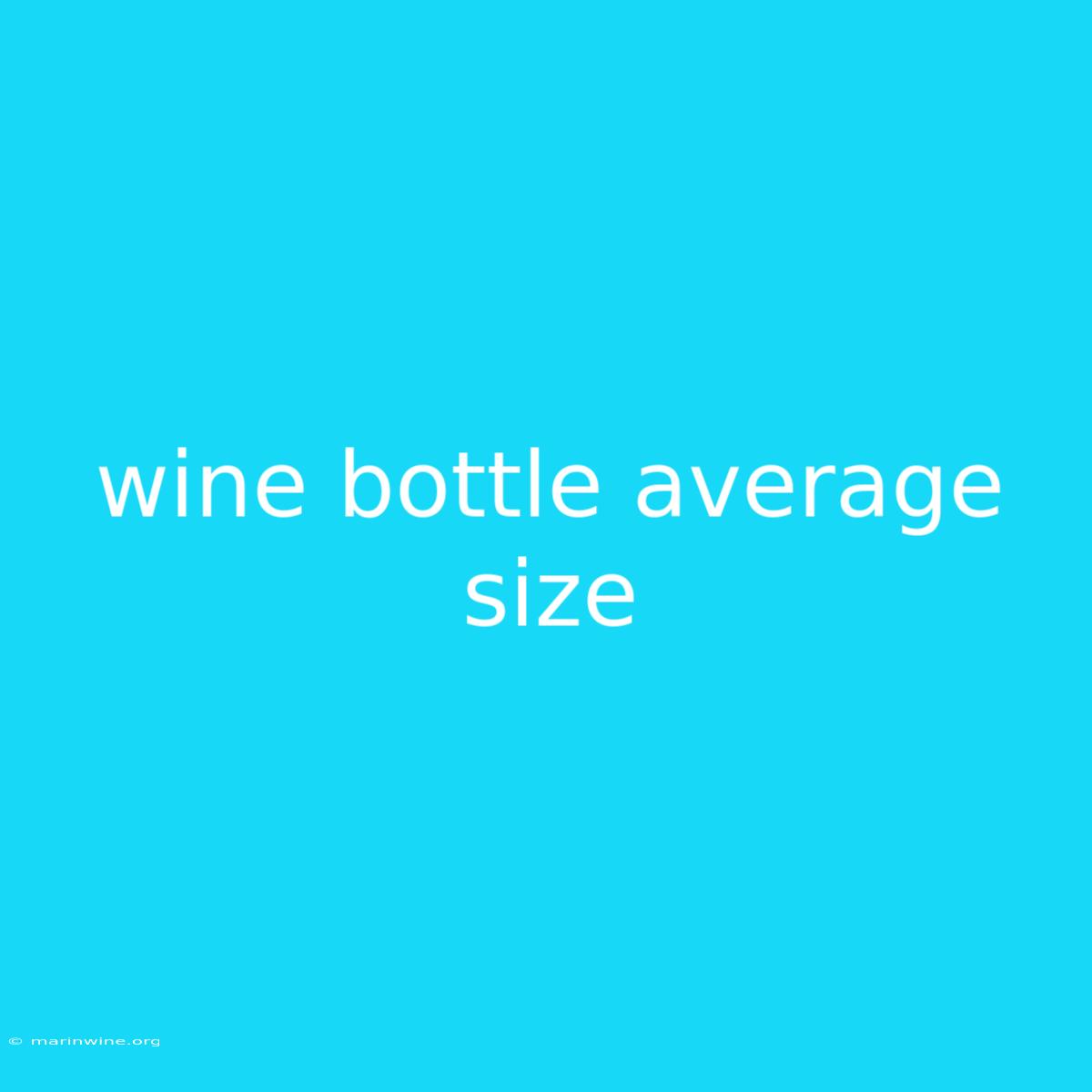What's the Average Size of a Wine Bottle? Uncorking the Mystery
Ever wondered why wine bottles seem to hold different amounts? It's true, they do, but there's actually a standard size that most wine bottles adhere to.
Why It Matters: Understanding the average size of a wine bottle helps you better gauge how much wine you're buying, plan for events, and even appreciate the history of winemaking. Plus, knowing the standard size allows you to compare prices and values across different wines more effectively.
Key Takeaways of Wine Bottle Sizes
| Size | Volume (mL) | Volume (fl oz) | Common Uses |
|---|---|---|---|
| Standard Bottle | 750 | 25.4 | Everyday drinking, sharing with friends |
| Magnum | 1500 | 50.7 | Special occasions, larger gatherings |
| Double Magnum | 3000 | 101.4 | Large events, wine collectors |
| Jeroboam | 3000 | 101.4 | Large events, wine collectors |
| Rehoboam | 4500 | 152.1 | Very large gatherings, prestigious occasions |
| Methuselah | 6000 | 202.8 | Extremely large gatherings, collectors' items |
| Salmanazar | 9000 | 304.2 | Very rare, for special events |
| Balthazar | 12000 | 405.6 | Extremely rare, for special events |
| Nebuchadnezzar | 15000 | 507 | Extremely rare, for special events |
Average Wine Bottle Size: The Standard 750ml
The most common wine bottle size is the standard 750ml bottle, which holds approximately 25.4 fluid ounces. This size has become the standard for various reasons:
- Historical Significance: Wine bottles have been around for centuries, with the 750ml size having its roots in early French winemaking.
- Practicality: The 750ml size is a practical size for everyday drinking, allowing for a few glasses per bottle without being too large or too small.
- International Standardization: The 750ml size has been adopted by most wine-producing regions globally, making it a universal standard.
Understanding Other Sizes: Variations and Their Significance
While the 750ml bottle reigns supreme, it's important to know that other sizes exist and have their own purposes. Here's a deeper look:
Large Format Bottles: These bottles, such as Magnums, Jeroboams, and even larger sizes, are typically used for special occasions or by collectors. They offer several advantages:
- Preservation: Large format bottles often age better due to the smaller surface area-to-volume ratio, which minimizes oxidation.
- Prestige: Larger bottles are often associated with luxury and prestige, making them ideal for celebratory events.
- Value: Larger bottles can offer better value per unit of wine, especially for rare or aged wines.
Smaller Format Bottles: Smaller bottles, like 375ml (half-bottles) or 187ml (split bottles) are becoming increasingly popular, especially for single-serving options. These smaller sizes are:
- Convenient: They are perfect for picnics, lunches, or when you don't want to open a full bottle.
- Cost-Effective: Smaller bottles are often more affordable, making them ideal for trying new wines or enjoying a glass without committing to a full bottle.
FAQ about Wine Bottle Size
Q: Why are there different sizes of wine bottles?
A: Different bottle sizes reflect historical practices, winemaking traditions, and the intended purpose of the wine. Large bottles offer better aging potential, while smaller bottles provide convenience and affordability.
Q: What is the most common size of wine bottle?
A: The most common size is the standard 750ml bottle, often referred to as a "fifth" in the US.
Q: How many glasses are in a 750ml bottle?
A: A 750ml bottle typically holds around 4-5 glasses of wine, depending on the glass size and serving style.
Q: What is a Magnum?
A: A Magnum is a larger format bottle holding 1.5 liters (1500ml) of wine, equivalent to two standard bottles.
Q: How can I tell the size of a wine bottle by looking at it?
A: While some larger bottles might have their size printed on the label, you can generally identify the bottle size by its height and girth. Larger bottles are taller and broader than standard bottles.
Q: Why are some wines bottled in larger sizes?
A: Larger bottles are often used for premium wines, especially for those that benefit from extended aging. They can also be used for special occasions or as collector's items.
Tips for Wine Bottle Sizes
- Consider the Occasion: For casual events, a standard 750ml bottle is a good choice. For larger gatherings or special occasions, consider a Magnum or a larger format.
- Value for Money: Larger bottles often offer better value per unit of wine, especially for rare or aged wines.
- Storage: Ensure you have adequate storage space for larger bottles.
- Try a Smaller Bottle: For a single serving or to try a new wine, a half-bottle or split bottle can be a great option.
Summary by Wine Bottle Size
This article explored the average size of a wine bottle, debunking the myth of the standard 750ml bottle and its variations. We discussed the historical significance of different sizes, practical implications for everyday use, and the unique characteristics of larger bottles. By understanding the world of wine bottle sizes, you can make more informed choices about the wine you purchase and enjoy.
Closing Message: Next time you visit a wine shop, pay attention to the bottle size. Consider the occasion, your budget, and your personal preferences when choosing the right bottle for your needs. Uncorking a bottle of wine is a wonderful experience, and knowing the right size will make it even more enjoyable!

